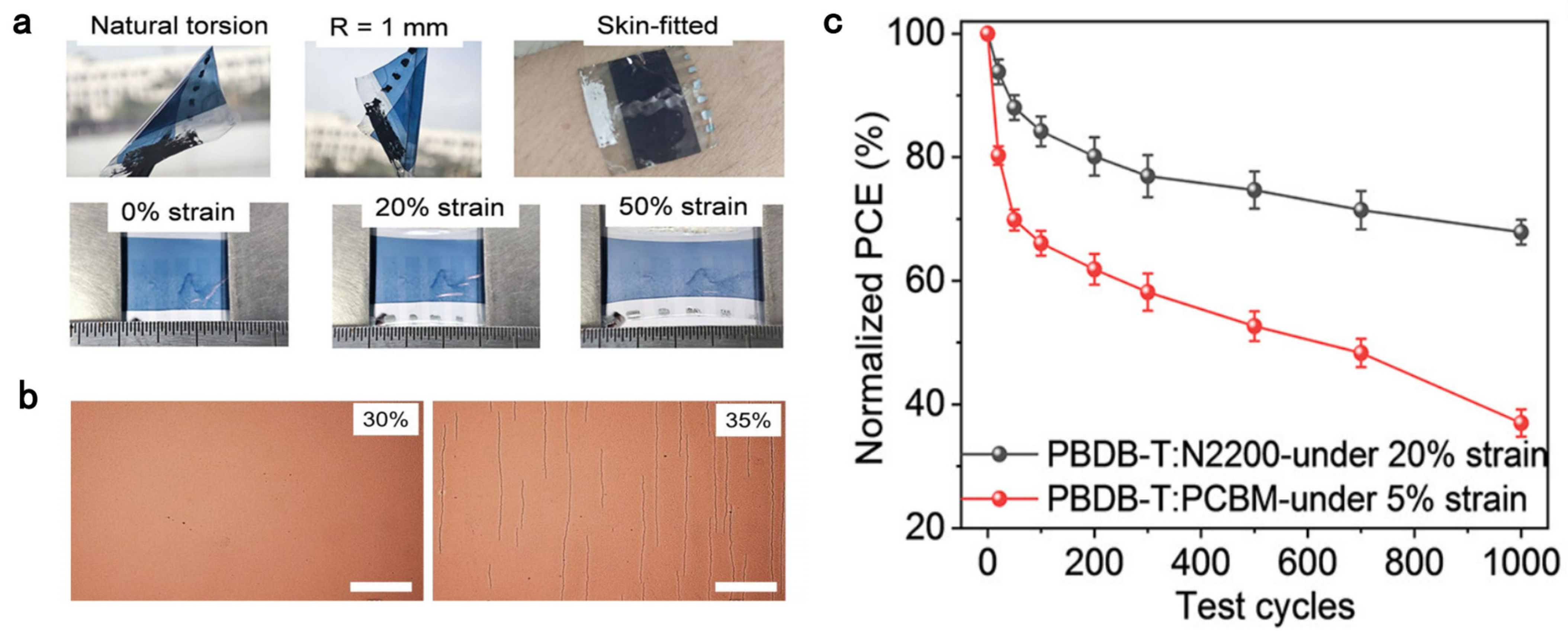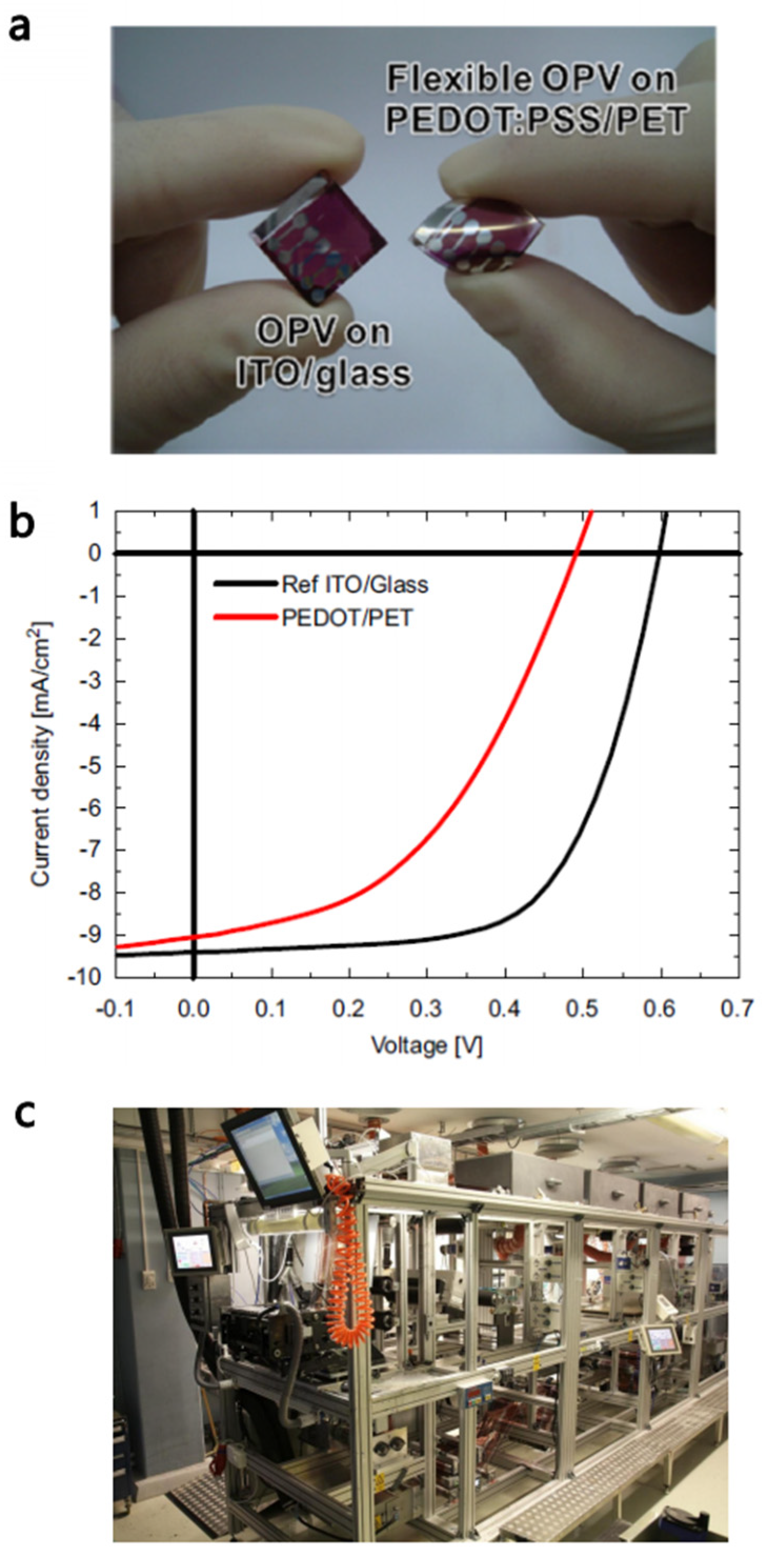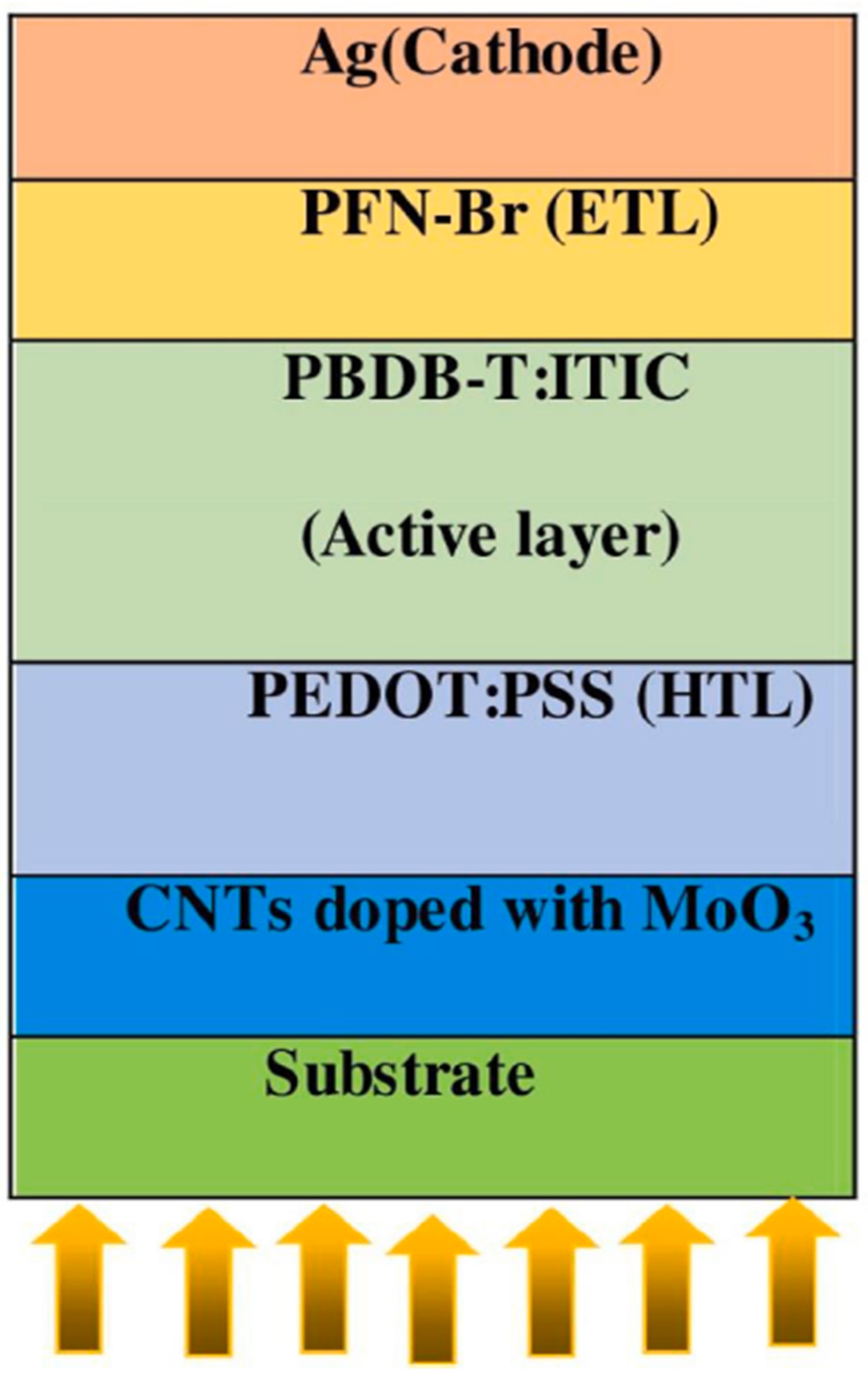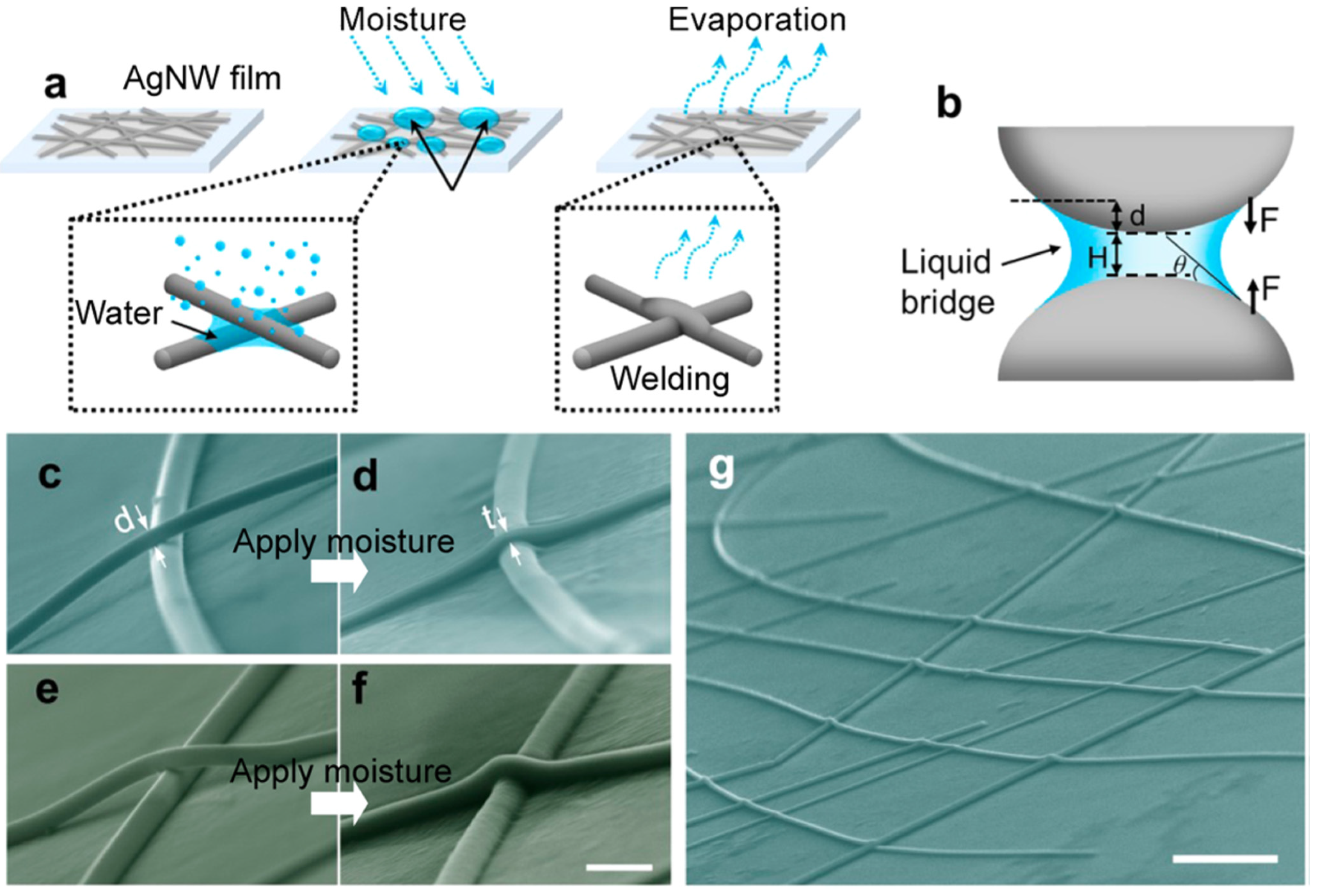A Review on Transparent Electrodes for Flexible Organic Solar Cells
Abstract
:1. Introduction
2. Conducting Polymer
3. Carbon Materials
3.1. Carbon Nanotubes
3.2. Graphene
4. Metal Nanowires
5. Conclusions
Author Contributions
Funding
Data Availability Statement
Conflicts of Interest
References
- Lipomi, D.J.; Tee, B.C.; Vosgueritchian, M.; Bao, Z. Stretchable Organic Solar Cells. Adv. Mater. 2011, 23, 1771–1775. [Google Scholar] [CrossRef] [PubMed]
- Qin, J.; Lan, L.; Chen, S.; Huang, F.; Shi, H.; Chen, W.; Xia, H.; Sun, K.; Yang, C. Recent Progress in Flexible and Stretchable Organic Solar Cells. Adv. Funct. Mater. 2020, 30, 2002529. [Google Scholar] [CrossRef]
- Kaltenbrunner, M.; White, M.S.; Głowacki, E.D.; Sekitani, T.; Someya, T.; Sariciftci, N.S.; Bauer, S. Ultrathin and lightweight organic solar cells with high flexibility. Nat. Commun. 2012, 3, 770. [Google Scholar] [CrossRef] [PubMed]
- Fukuda, K.; Yu, K.; Someya, T. The Future of Flexible Organic Solar Cells. Adv. Energy Mater. 2020, 10, 2000765. [Google Scholar] [CrossRef]
- Ellmer, K. Past achievements and future challenges in the development of optically transparent electrodes. Nat. Photon. 2012, 6, 809–817. [Google Scholar] [CrossRef]
- Haris, M.; Ullah, Z.; Lee, S.; Ryu, D.H.; Ryu, S.U.; Kang, B.J.; Jeon, N.J.; Kim, B.J.; Park, T.; Shin, W.S.; et al. Amplifying High-Performance Organic Solar Cells Through Differencing Interactions of Solid Additive with Donor/Acceptor Materials Processed from Non-Halogenated Solvent. Adv. Energy Mater. 2024. Early View. [Google Scholar] [CrossRef]
- Dhal, B.C.; Hajra, S.; Priyadarshini, A.; Panda, S.; Vivekananthan, V.; Swain, J.; Swain, S.; Das, N.; Samantray, R.; Kim, H.J.; et al. Innovative Synthesis of Zeolitic Imidazolate Framework by a Stovetop Kitchen Pressure Cook Pot for Triboelectric Nanogenerator. Energy Technol. 2024, 12, 2400099. [Google Scholar] [CrossRef]
- Wang, Z.; Zhang, D.; Xu, M.; Liu, J.; He, J.; Yang, L.; Li, Z.; Gao, Y.; Chen, Y.; Gong, H.; et al. Revealing the Strain-Induced Morphological, Mechanical, and Photovoltaic Evolution of Self-Encapsulated and Semitransparent Intrinsically Stretchable Organic Solar Cells. ACS Mater. Lett. 2024, 6, 1811–1819. [Google Scholar] [CrossRef]
- Haris, M.; Ryu, D.H.; Ullah, Z.; Kang, B.J.; Jeon, N.J.; Lee, S.; Lee, H.K.; Lee, S.K.; Lee, J.C.; Kwon, H.W.; et al. Morphological modulation enabled by non-halogenated solvent-processed simple solid additives for high-efficiency organic solar cells. EcoMat 2024, 6, e12436. [Google Scholar] [CrossRef]
- Bayoumy, A.M.; Hessein, A.; Belal, M.A.; Ezzat, M.; Ibrahim, M.A.; Osman, A.; El-Moneim, A.A. Microdrop InkJet printed supercapacitors of graphene/graphene oxide ink for flexible electronics. J. Power Sources 2024, 617, 235145. [Google Scholar] [CrossRef]
- Arshad, F.; Haris, M.; Oh, E.S.; Ullah, Z.; Ryu, D.H.; Lee, S.; Lee, H.K.; Lee, S.K.; Kim, T.; Kwon, H.; et al. Hydrogen-Bonding Interactions Between Terpolymers Enable Excellent Device Efficiency and Operational Stability of Non-Halogenated Solvent-Processed Polymer Solar Cells. Adv. Funct. Mater. 2024. Early View. [Google Scholar] [CrossRef]
- Cao, W.; Li, J.; Chen, H.; Xue, J. Transparent electrodes for organic optoelectronic devices: A review. J. Photon. Energy 2014, 4, 040990. [Google Scholar] [CrossRef]
- Choi, K.-H.; Jeong, J.-A.; Kang, J.-W.; Kim, D.-G.; Kim, J.K.; Na, S.-I.; Kim, D.-Y.; Kim, S.-S.; Kim, H.-K. Characteristics of flexible indium tin oxide electrode grown by continuous roll-to-roll sputtering process for flexible organic solar cells. Sol. Energy Mater. Sol. Cells 2009, 93, 1248–1255. [Google Scholar] [CrossRef]
- Lin, H.; Hsu, W. Electrode patterning of ITO thin films by high repetition rate fiber laser. Appl. Surf. Sci. 2014, 308, 58–62. [Google Scholar] [CrossRef]
- Sibin, K.; Swain, N.; Chowdhury, P.; Dey, A.; Sridhara, N.; Shashikala, H.; Sharma, A.K.; Barshilia, H.C. Optical and electrical properties of ITO thin films sputtered on flexible FEP substrate as passive thermal control system for space applications. Sol. Energy Mater. Sol. Cells 2016, 145, 314–322. [Google Scholar] [CrossRef]
- Sakamoto, K.; Kuwae, H.; Kobayashi, N.; Nobori, A.; Shoji, S.; Mizuno, J. Highly flexible transparent electrodes based on mesh-patterned rigid indium tin oxide. Sci. Rep. 2018, 8, 2825. [Google Scholar] [CrossRef] [PubMed]
- Bender, M.; Seelig, W.; Daube, C.; Frankenberger, H.; Ocker, B.; Stollenwerk, J. Dependence of film composition and thicknesses on optical and electrical properties of ITO–metal–ITO multilayers. Thin Solid Films 1998, 326, 67–71. [Google Scholar] [CrossRef]
- Lewis, J.; Grego, S.; Chalamala, B.; Vick, E.; Temple, D. Highly flexible transparent electrodes for organic light-emitting diode-based displays. Appl. Phys. Lett. 2004, 85, 3450–3452. [Google Scholar] [CrossRef]
- Huang, W.; Jiang, Z.; Fukuda, K.; Jiao, X.; McNeill, C.R.; Yokota, T.; Someya, T. Efficient and Mechanically Robust Ultraflexible Organic Solar Cells Based on Mixed Acceptors. Joule 2019, 4, 128–141. [Google Scholar] [CrossRef]
- Wan, J.; Fan, X.; Li, Y.; Li, P.; Zhang, T.; Hui, K.N.; Huang, H.; Kang, K.; Qian, L. High-Efficiency Flexible Organic Photovoltaics and Thermoelectricities Based on Thionyl Chloride Treated PEDOT:PSS Electrodes. Front. Chem. 2021, 9, 807538. [Google Scholar] [CrossRef]
- Koo, D.; Jung, S.; Seo, J.; Jeong, G.; Choi, Y.; Lee, J.; Lee, S.M.; Cho, Y.; Jeong, M.; Lee, J.; et al. Flexible Organic Solar Cells Over 15% Efficiency with Polyimide-Integrated Graphene Electrodes. Joule 2020, 4, 1021–1034. [Google Scholar] [CrossRef]
- Chen, X.; Xu, G.; Zeng, G.; Gu, H.; Chen, H.; Xu, H.; Yao, H.; Li, Y.; Hou, J.; Li, Y. Realizing Ultrahigh Mechanical Flexibility and >15% Efficiency of Flexible Organic Solar Cells via a “Welding” Flexible Transparent Electrode. Adv. Mater. 2020, 32, e1908478. [Google Scholar] [CrossRef]
- Sharma, B.; Mathur, A.; Singh, I.K.; Singh, B. Performance optimization of non-fullerene acceptor organic solar cell by incorporating carbon nanotubes as flexible transparent electrode. Results Opt. 2022, 9, 100315. [Google Scholar] [CrossRef]
- Krantz, J.; Richter, M.; Spallek, S.; Spiecker, E.; Brabec, C.J. Solution-Processed Metallic Nanowire Electrodes as Indium Tin Oxide Replacement for Thin-Film Solar Cells. Adv. Funct. Mater. 2011, 21, 4784–4787. [Google Scholar] [CrossRef]
- Hecht, D.S.; Hu, L.; Irvin, G. Emerging Transparent Electrodes Based on Thin Films of Carbon Nanotubes, Graphene, and Metallic Nanostructures. Adv. Mater. 2011, 23, 1482–1513. [Google Scholar] [CrossRef] [PubMed]
- Sandström, A.; Dam, H.F.; Krebs, F.C.; Edman, L. Ambient fabrication of flexible and large-area organic light-emitting devices using slot-die coating. Nat. Commun. 2012, 3, 1002. [Google Scholar] [CrossRef]
- Liu, C.; Xiao, C.; Xie, C.; Li, W. Flexible organic solar cells: Materials, large-area fabrication techniques and potential applications. Nano Energy 2021, 89, 106399. [Google Scholar] [CrossRef]
- Gao, W.; Ota, H.; Kiriya, D.; Takei, K.; Javey, A. Flexible Electronics toward Wearable Sensing. Accounts Chem. Res. 2019, 52, 523–533. [Google Scholar] [CrossRef]
- Li, X.; Li, P.; Wu, Z.; Luo, D.; Yu, H.-Y.; Lu, Z.-H. Review and perspective of materials for flexible solar cells. Mater. Rep. Energy 2021, 1, 100001. [Google Scholar] [CrossRef]
- Lipomi, D.J.; Vosgueritchian, M.; Tee, B.C.K.; Hellstrom, S.L.; Lee, J.A.; Fox, C.H.; Bao, Z. Skin-like pressure and strain sensors based on transparent elastic films of carbon nanotubes. Nat. Nanotechnol. 2011, 6, 788–792. [Google Scholar] [CrossRef]
- Kim, Y.H.; Sachse, C.; Machala, M.L.; May, C.; Müller-Meskamp, L.; Leo, K. Highly Conductive PEDOT:PSS Electrode with Optimized Solvent and Thermal Post-Treatment for ITO-Free Organic Solar Cells. Adv. Funct. Mater. 2011, 21, 1076–1081. [Google Scholar] [CrossRef]
- Hsiao, Y.-S.; Chen, C.-P.; Chao, C.-H.; Whang, W.-T. All-solution-processed inverted polymer solar cells on granular surface-nickelized polyimide. Org. Electron. 2009, 10, 551–561. [Google Scholar] [CrossRef]
- Peng, B.; Guo, X.; Cui, C.; Zou, Y.; Pan, C.; Li, Y. Performance improvement of polymer solar cells by using a solvent-treated poly(3,4-ethylenedioxythiophene):poly(styrenesulfonate) buffer layer. Appl. Phys. Lett. 2011, 98, 243308. [Google Scholar] [CrossRef]
- Kayser, L.V.; Lipomi, D.J. Stretchable Conductive Polymers and Composites Based on PEDOT and PEDOT:PSS. Adv. Mater. 2019, 31, e1806133. [Google Scholar] [CrossRef] [PubMed]
- Zhang, W.; Zhao, B.; He, Z.; Zhao, X.; Wang, H.; Yang, S.; Wu, H.; Cao, Y. High-efficiency ITO-free polymer solar cells using highly conductive PEDOT:PSS/surfactant bilayer transparent anodes. Energy Environ. Sci. 2013, 6, 1956–1964. [Google Scholar] [CrossRef]
- Hau, S.K.; Yip, H.-L.; Zou, J.; Jen, A.K.-Y. Indium tin oxide-free semi-transparent inverted polymer solar cells using conducting polymer as both bottom and top electrodes. Org. Electron. 2009, 10, 1401–1407. [Google Scholar] [CrossRef]
- Zhang, F.; Johansson, M.; Andersson, M.R.; Hummelen, J.C.; Inganäs, O. Polymer Photovoltaic Cells with Conducting Polymer Anodes. Adv. Mater. 2002, 14, 662–665. [Google Scholar] [CrossRef]
- Kim, Y.Y.; Yang, T.Y.; Suhonen, R.; Valimaki, M.; Maaninen, T.; Kemppainen, A.; Jeon, N.J.; Seo, J. Gravure-Printed Flexible Perovskite Solar Cells: Toward Roll-to-Roll Manufacturing. Adv. Sci. 2019, 6, 1802094. [Google Scholar] [CrossRef] [PubMed]
- Cho, C.K.; Hwang, W.J.; Eun, K.; Choa, S.H.; Na, S.I.; Kim, H.K. Mechanical flexibility of transparent PEDOT:PSS electrodes prepared by gravure printing for flexible organic solar cells. Sol. Energy Mater. Sol. Cells 2011, 95, 3269–3275. [Google Scholar] [CrossRef]
- Na, S.; Kim, S.; Jo, J.; Kim, D. Efficient and Flexible ITO-Free Organic Solar Cells Using Highly Conductive Polymer Anodes. Adv. Mater. 2008, 20, 4061–4067. [Google Scholar] [CrossRef]
- Vosgueritchian, M.; Lipomi, D.J.; Bao, Z. Highly Conductive and Transparent PEDOT:PSS Films with a Fluorosurfactant for Stretchable and Flexible Transparent Electrodes. Adv. Funct. Mater. 2011, 22, 421–428. [Google Scholar] [CrossRef]
- Lupu, D.; Grüneis, A.; Ayala, P.; Rümmeli, M.H.; Pichler, T.; Li, Z.; Xu, Y.; Misan, I.; Dervishi, E.; Biris, A.S. High-Quality Double-Walled Carbon Nanotubes Grown by a Cold-Walled Radio Frequency Chemical Vapor Deposition Process. Chem. Mater. 2008, 20, 3466–3472. [Google Scholar] [CrossRef]
- Baughman, R.H.; Zakhidov, A.A.; de Heer, W.A. Carbon nanotubes—The route toward applications. Science 2002, 297, 787–792. [Google Scholar] [CrossRef] [PubMed]
- Fu, X.; Xu, L.; Li, J.; Sun, X.; Peng, H. Flexible solar cells based on carbon nanomaterials. Carbon 2018, 139, 1063–1073. [Google Scholar] [CrossRef]
- Zhang, Z.; Wei, L.; Qin, X.; Li, Y. Carbon nanomaterials for photovoltaic process. Nano Energy 2015, 15, 490–522. [Google Scholar] [CrossRef]
- De Arco, L.G.; Zhang, Y.; Schlenker, C.W.; Ryu, K.; Thompson, M.E.; Zhou, C. Continuous, Highly Flexible, and Transparent Graphene Films by Chemical Vapor Deposition for Organic Photovoltaics. ACS Nano 2015, 4, 2865–2873. [Google Scholar] [CrossRef] [PubMed]
- Eda, G.; Fanchini, G.; Chhowalla, M. Large-area ultrathin films of reduced graphene oxide as a transparent and flexible electronic material. Nat. Nanotechnol. 2008, 3, 270–274. [Google Scholar] [CrossRef] [PubMed]
- Shin, D.H.; Seo, S.W.; Kim, J.M.; Lee, H.S.; Choi, S.-H. Graphene transparent conductive electrodes doped with graphene quantum dots-mixed silver nanowires for highly-flexible organic solar cells. J. Alloys Compd. 2018, 744, 1–6. [Google Scholar] [CrossRef]
- Bae, S.; Kim, H.; Lee, Y.; Xu, X.; Park, J.-S.; Zheng, Y.; Balakrishnan, J.; Lei, T.; Kim, H.R.; Song, Y.I.; et al. Roll-to-roll production of 30-inch graphene films for transparent electrodes. Nat. Nanotechnol. 2010, 5, 574–578. [Google Scholar] [CrossRef]
- Kwon, S.-J.; Han, T.-H.; Ko, T.Y.; Li, N.; Kim, Y.; Kim, D.J.; Bae, S.-H.; Yang, Y.; Hong, B.H.; Kim, K.S.; et al. Extremely stable graphene electrodes doped with macromolecular acid. Nat. Commun. 2018, 9, 1–9. [Google Scholar] [CrossRef]
- Song, Y.; Chang, S.; Gradecak, S.; Kong, J. Visibly-Transparent Organic Solar Cells on Flexible Substrates with All-Graphene Electrodes. Adv. Energy Mater. 2016, 6, 1600847. [Google Scholar] [CrossRef]
- Park, H.; Chang, S.; Zhou, X.; Kong, J.; Palacios, T.; Gradečak, S. Flexible Graphene Electrode-Based Organic Photovoltaics with Record-High Efficiency. Nano Lett. 2014, 14, 5148–5154. [Google Scholar] [CrossRef] [PubMed]
- Rathmell, A.R.; Wiley, B.J. The Synthesis and Coating of Long, Thin Copper Nanowires to Make Flexible, Transparent Conducting Films on Plastic Substrates. Adv. Mater. 2011, 23, 4798–4803. [Google Scholar] [CrossRef]
- Sánchez-Iglesias, A.; Rivas-Murias, B.; Grzelczak, M.; Pérez-Juste, J.; Liz-Marzán, L.M.; Rivadulla, F.; Correa-Duarte, M.A. Highly Transparent and Conductive Films of Densely Aligned Ultrathin Au Nanowire Monolayers. Nano Lett. 2012, 12, 6066–6070. [Google Scholar] [CrossRef] [PubMed]
- Sannicolo, T.; Lagrange, M.; Cabos, A.; Celle, C.; Simonato, J.; Bellet, D. Metallic Nanowire-Based Transparent Electrodes for Next Generation Flexible Devices: A Review. Small 2016, 12, 6052–6075. [Google Scholar] [CrossRef]
- Zhang, D.; Wang, R.; Wen, M.; Weng, D.; Cui, X.; Sun, J.; Li, H.; Lu, Y. Synthesis of Ultralong Copper Nanowires for High-Performance Transparent Electrodes. J. Am. Chem. Soc. 2012, 134, 14283–14286. [Google Scholar] [CrossRef]
- Tokuno, T.; Nogi, M.; Karakawa, M.; Jiu, J.; Nge, T.T.; Aso, Y.; Suganuma, K. Fabrication of silver nanowire transparent electrodes at room temperature. Nano Res. 2011, 4, 1215–1222. [Google Scholar] [CrossRef]
- Sun, Y.; Chang, M.; Meng, L.; Wan, X.; Gao, H.; Zhang, Y.; Zhao, K.; Sun, Z.; Li, C.; Liu, S.; et al. Flexible organic photovoltaics based on water-processed silver nanowire electrodes. Nat. Electron. 2019, 2, 513–520. [Google Scholar] [CrossRef]
- Liu, Y.; Zhang, J.; Gao, H.; Wang, Y.; Liu, Q.; Huang, S.; Guo, C.F.; Ren, Z. Capillary-Force-Induced Cold Welding in Silver-Nanowire-Based Flexible Transparent Electrodes. Nano Lett. 2017, 17, 1090–1096. [Google Scholar] [CrossRef]
- Yin, Z.; Chen, S.; Guan, Y.; Ran, Q.; Zhang, Q.; Yan, X.; Jin, R.; Yu, H.; Li, L.; Yu, J. Copper Nanowire Dispersion through an Electrostatic Dispersion Mechanism for High-Performance Flexible Transparent Conducting Films and Optoelectronic Devices. ACS Appl. Mater. Interfaces 2019, 11, 5264–5275. [Google Scholar] [CrossRef]







| Electrode | Active Layer | PCE | Year |
|---|---|---|---|
| ITO | P3HT:PCBM | 3.3% | 2008 |
| ITO | PTB7-TH:IEIC | 2.26% | 2016 |
| Su-8/ITO | PBDTTT-OFT:IEICO-4F:PC71BM | 13% | 2020 |
| PEDOT:PSS | P3HT:PCBM | 2.8% | 2008 |
| SOCl2-treated PEDOT:PSS | PM6:Y6 | 13.69% | 2022 |
| ITO and graphene | PM6:Y6 | 15.2% | 2020 |
| CNTs(MoO3) | PBDB-T:ITIC | 27.57% | 2022 |
| AgNWs(Al/AZO) | PBDB-T-2F:Y6 | 15.21% | 2020 |
Disclaimer/Publisher’s Note: The statements, opinions and data contained in all publications are solely those of the individual author(s) and contributor(s) and not of MDPI and/or the editor(s). MDPI and/or the editor(s) disclaim responsibility for any injury to people or property resulting from any ideas, methods, instructions or products referred to in the content. |
© 2024 by the authors. Licensee MDPI, Basel, Switzerland. This article is an open access article distributed under the terms and conditions of the Creative Commons Attribution (CC BY) license (https://creativecommons.org/licenses/by/4.0/).
Share and Cite
Li, Y.; Sha, M.; Huang, S. A Review on Transparent Electrodes for Flexible Organic Solar Cells. Coatings 2024, 14, 1031. https://doi.org/10.3390/coatings14081031
Li Y, Sha M, Huang S. A Review on Transparent Electrodes for Flexible Organic Solar Cells. Coatings. 2024; 14(8):1031. https://doi.org/10.3390/coatings14081031
Chicago/Turabian StyleLi, Yiyun, Mengzhen Sha, and Shufen Huang. 2024. "A Review on Transparent Electrodes for Flexible Organic Solar Cells" Coatings 14, no. 8: 1031. https://doi.org/10.3390/coatings14081031






